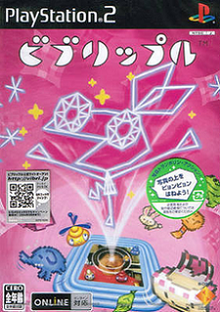| Vib-Ripple | |
|---|---|
 | |
| Developer(s) | NanaOn-Sha |
| Publisher(s) | Sony Computer Entertainment |
| Designer(s) | Masaya Matsuura |
| Platform(s) | PlayStation 2 |
| Release |
|
| Genre(s) | Action |
| Mode(s) | Single-player |
Vib-Ripple is a 2004 video game developed by NanaOn-Sha and published by Sony Computer Entertainment for the PlayStation 2. It was designed by Masaya Matsuura, who also led the development the 1999 PlayStation game Vib-Ribbon, to which Vib-Ripple is a sequel. It was released exclusively in Japan.
The game was first mentioned in a catalog list of presentation at the 2002 Game Developers' Conference with a talk by Masaya Matsuura titled "The Game Design of Vib Ribbon 2".
Vib-Ripple is notable for allowing the player to import photographs to be used as the game's playing field.
Gameplay
The player takes control of Vibri, a simple, vector-shaped rabbit from the game's predecessor Vib-Ribbon. The game puts the player on top of various photographs, using each one as a trampoline. Jumping on a photograph loosens up 2D items called "Peta Characters", which Vibri must collect before a time limit expires. An icon on the left side of the screen gives the player a hint as to what part of the photograph to jump on to find the item; the icon's color, shape, and size corresponds to a certain combination of the three on the photograph. When Vibri is close enough to the item, a drumming sound is made and the controller vibrates. Vibri must also avoid creatures called "Boonchies" that inhabit the surface of the picture. Coming in contact with a Boonchie will cause Vibri to de-evolve from a rabbit, to a frog, to a worm, and eventually cause a Game over. However, it is possible for Vibri to evolve into a form called "Super Vibri", allowing the player to temporarily disable a Boonchie, as well as see hidden Peta Characters.
Vib-Ripple has 60 default photographs. The player can create their own stages by uploading their own photographs from a digital camera or cellphone via the PlayStation 2's USB port, or even send pictures across the system's online network. The game automatically scales photographs down to 256 by 256 pixels.
See also
Notes
- Additional work by Japan Studio.
- Japanese: ビブリップル, Hepburn: Biburippuru
References
- "JAPANスタジオ作品一覧 2005年~2003年" [List of Japan Studio works 2005–2003] (in Japanese). Sony Interactive Entertainment. 2021. Archived from the original on February 25, 2021. Retrieved March 1, 2021.
- Fox, Matt (2013). The video games guide: 1,000+ arcade, console and computer games, 1962-2012 (2nd ed.). Jefferson, N.C: McFarland & Company, Inc., Publishers. p. 315. ISBN 978-0-7864-7257-4.
- "Gaming Intelligence Agency - Vib Ribbon 2 confirmed for development". archive.thegia.com. January 17, 2002. Retrieved July 12, 2024.
- ^ Gantayat, Anoop (May 28, 2004). "Vib Ripple Playtest". IGN.com. Retrieved November 9, 2008.
- Vib-Ripple Manual. Japan: Sony Computer Entertainment. 2004. p. 32.
External links
This music video game–related article is a stub. You can help Misplaced Pages by expanding it. |
- 2004 video games
- Action games
- Japan Studio games
- Japan-exclusive video games
- NanaOn-Sha games
- Photography games
- PlayStation 2 games
- PlayStation 2-only games
- Rhythm games
- Single-player video games
- Sony Interactive Entertainment games
- Video game sequels
- Video games about evolution
- Video games about rabbits and hares
- Video games developed in Japan
- Music video game stubs